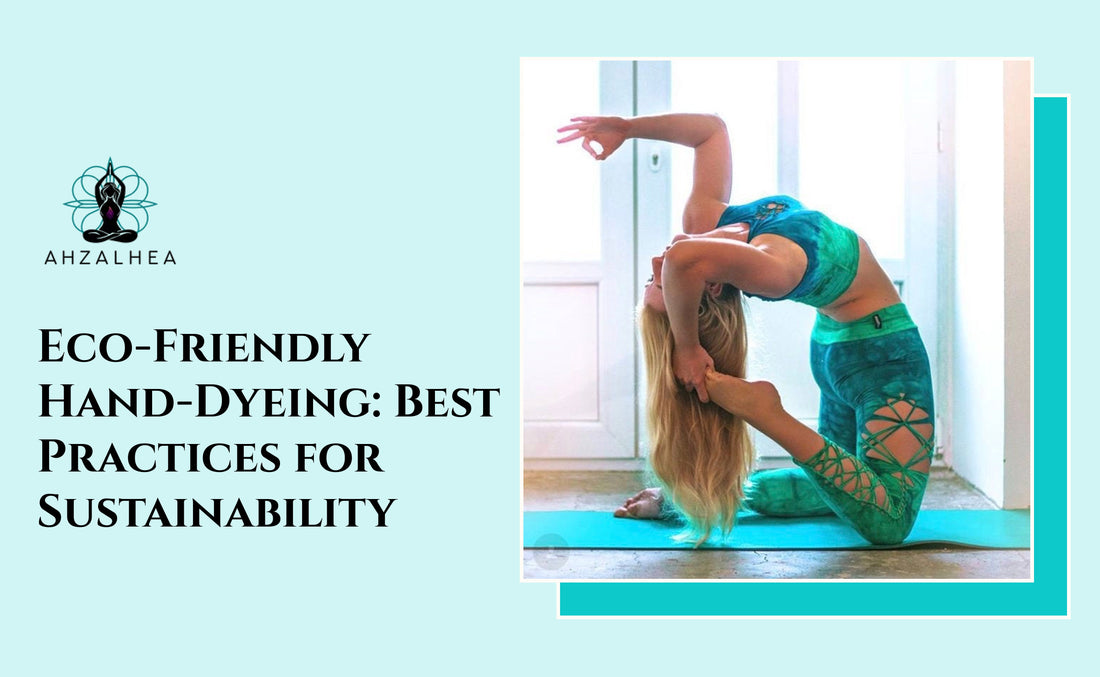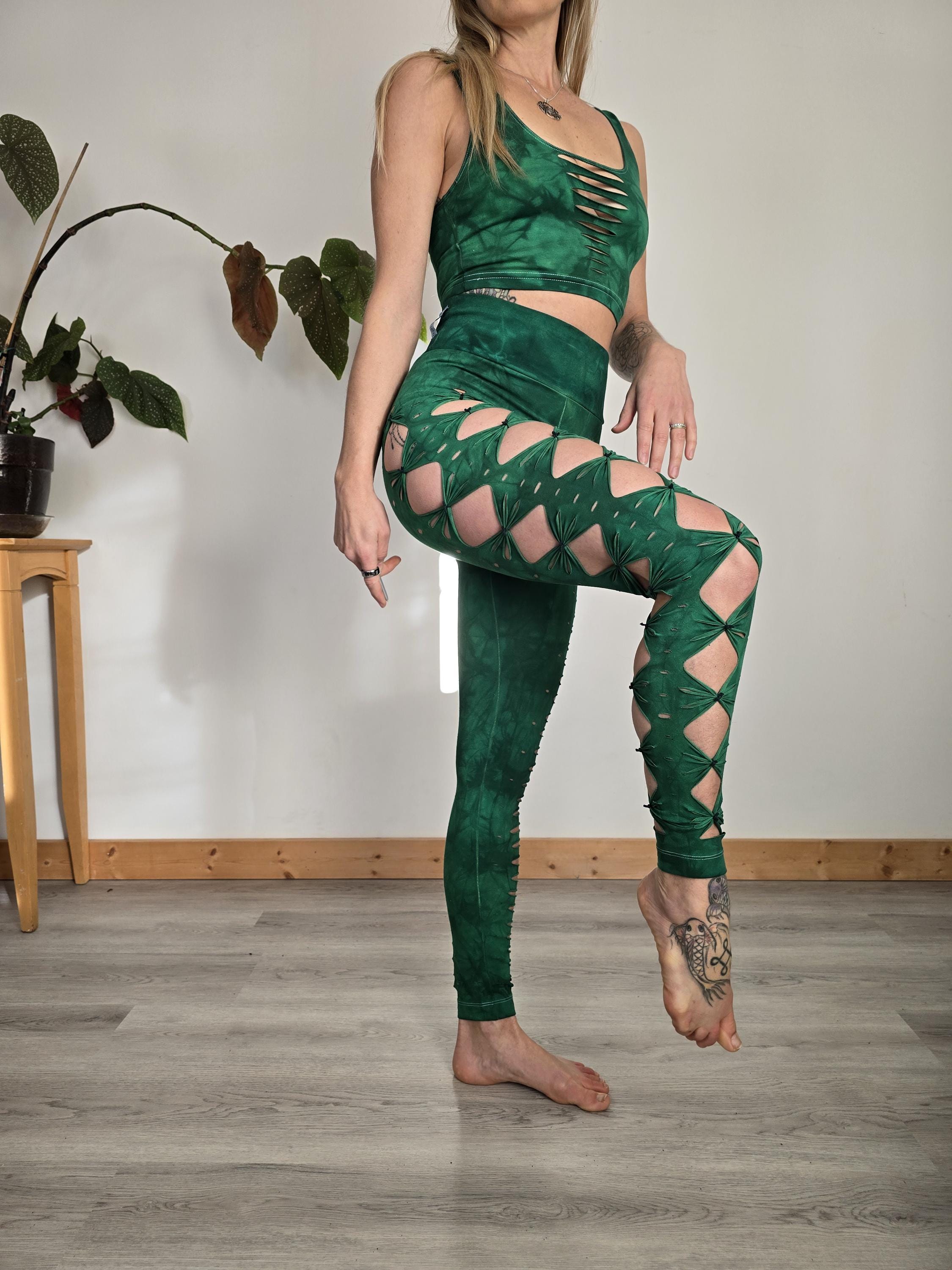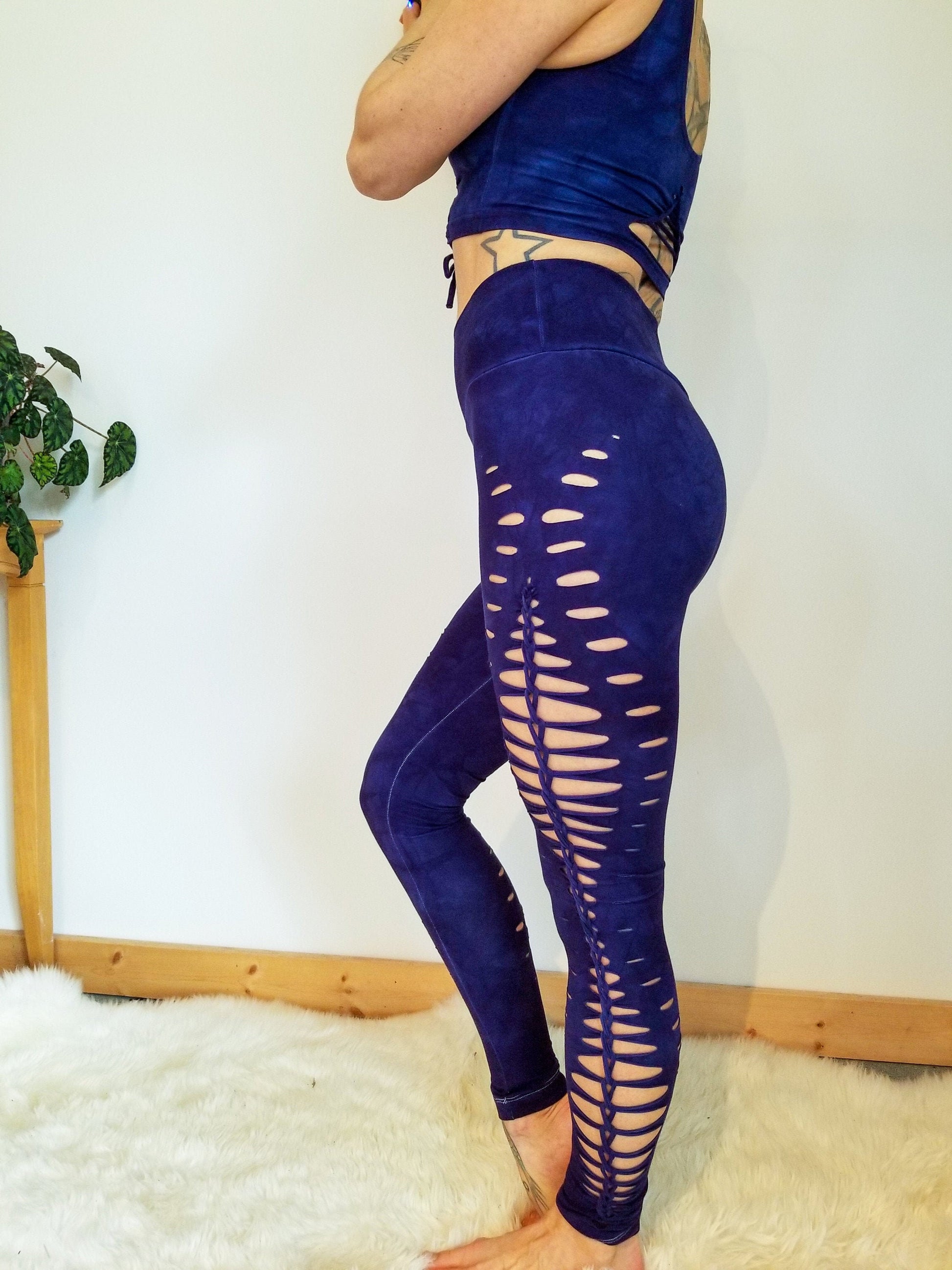
Eco-Friendly Hand-Dyeing: Best Practices for Sustainability
Share
Hand-dyeing is a beautiful art form that creates unique, vibrant textiles. It's important to think about how our dyeing affects the environment, especially now when taking care of our planet is so crucial. In this article, we'll explore how to do hand-dyeing in a way that's good for the Earth, so you can make amazing fabrics while helping to protect nature.
Key Takeaways for Sustainable Hand-Dyeing
- Use natural dyes from plants and minerals
- Save water when dyeing
- Use fewer chemicals by choosing natural options
- Use methods that don't waste energy
- Reduce waste in dyeing by recycling and reusing
- Pick fabrics that are good for the environment, like organic cotton
- Use packaging that breaks down naturally or is recycled
- Look for certifications that show products are eco-friendly
At Ahzalhea, we love making beautiful, hand-dyed yoga clothes while being kind to the environment. We care about being eco-friendly in everything we do, from getting materials to packaging and shipping. Let's look at some ways to make hand-dyeing better for the planet, whether you're doing it at home or in a big workshop.
Choosing Eco-Friendly Dyes
Picking the right dyes is super important for eco-friendly hand-dyeing. Natural dyes from plants, minerals, and even some bugs are much better for the environment than artificial ones. These dyes break down easily and don't put bad chemicals into our water. They're safer for the environment and for people wearing the clothes. Plus, natural dyes often make rich, interesting colors that artificial dyes can't copy, making your fabrics look extra special.
Here are some great natural dyes you can try:
- Indigo (blue): Comes from indigo plant leaves and makes different shades of blue.
- Madder root (red): From the roots of the madder plant, it makes warm reds and pinks.
- Turmeric (yellow): A spice that makes bright yellow dye.
- Logwood (purple): From the middle of the logwood tree, it makes rich purples.
- Onion skins (orange to brown): A great way to use kitchen scraps for dyeing.
- Avocado pits and skins (pink): Another kitchen leftover that surprisingly makes soft pink colors.
- Weld (yellow): A plant that's been used for dyeing for a long time and makes bright yellows.
When you're choosing dyes, look for ones that have special labels like GOTS or OEKO-TEX. These labels mean the dyes are made in ways that are good for the environment and safe to use. You can also look for plants near where you live that might work for dyeing. Using local plants is even better for the environment because they don't have to travel far.
Water Conservation Techniques
Water is really important, and dyeing clothes can use a lot of it. The clothing industry uses more water than almost any other industry in the world. That's why it's so important to save water when we're dyeing. Here are some ways to use less water when you're hand-dyeing:
- Use dye baths more than once: Many natural dyes can be used several times before they stop working well. This saves water and helps you use all of your dye.
- Collect rainwater: Use rainwater for your dye baths instead of water from the tap. This saves treated water and can make your dyes work better because rainwater doesn't have chemicals like chlorine in it.
- Try methods that use less water: Things like ice dyeing or steam dyeing use less water. For example, with ice dyeing, you put ice on top of fabric and sprinkle dye powder over it. As the ice melts, it makes cool patterns without using much water.
- Set up a system to reuse water: If you can, set up a way to catch and clean the water from your dye baths. You can use this cleaned water for things like watering plants or cleaning your tools.
- Try bundle dyeing: This is when you wrap fabric tightly around plants and steam it. It uses very little water and makes unique patterns.
At Ahzalhea, we really care about saving water when we dye clothes. We have special systems to reuse water and we're always looking for new ways to use less water without making our hand-dyed clothes any less colorful or beautiful.
Minimizing Chemical Usage
Regular dyeing often uses harsh chemicals that can hurt the environment and be bad for people's health. To make your hand-dyeing safer and better for the planet, try these eco-friendly options:
- Use natural mordants: Things like alum, tannins from plants like oak galls, and iron are safer ways to help dyes stick to fabric. These natural options work well without hurting the environment like artificial mordants do.
- Try changing the pH: Vinegar and baking soda can naturally change how acidic or basic your dye is, which can affect the color. Vinegar can make reds and pinks brighter, while baking soda can make blues and purples stronger.
- Skip toxic additives: Don't use chemical brighteners. Instead, try natural ways to make colors stronger. For example, adding salt to your dye bath can make colors more intense on plant-based fabrics.
- Look into bio-mordants: Some plants, like rhubarb leaves, naturally have stuff in them that helps dyes stick to fabric.
- Use soy milk as a binder: For some natural dyes, especially on plant fabrics, soy milk can help the dye stick better in an eco-friendly way.
Energy-Efficient Dyeing Methods
Using less energy when dyeing is another important way to be eco-friendly. By using energy-smart methods, you can really reduce how much your dyeing affects the environment. Here are some tips to save energy:
- Use solar dyeing: Let the sun do the work by leaving dye baths outside on sunny days. This saves energy and can make cool effects as the dye slowly soaks into the fabric.
- Try cold-water dyeing: Some natural dyes work well in cold water, which saves energy on heating. Indigo, for example, actually works better in cooler water.
- Insulate your dye pots: Keep heat in and waste less energy by wrapping your dye pots in old towels or using a special insulating cover.
- Use leftover heat: If you do need to heat your dye bath, turn off the heat once it's hot enough and let the leftover heat keep dyeing the fabric. This works especially well with wool and other animal fibers.
- Choose dyes that work in cool water: Some new, eco-friendly dyes are made to work at lower temperatures, which uses less energy but still makes good colors.
- Do two steps at once: If you can, do the mordanting (which helps the dye stick) and dyeing in one bath to save energy and water.
These methods not only save energy but can also create unique effects in your hand-dyed festival wear. At Ahzalhea, we've found that energy-saving dyeing methods often lead to exciting color variations and patterns that our customers love, showing that being eco-friendly can also be creative and fun.
Waste Reduction Strategies
Reducing waste is really important for eco-friendly hand-dyeing. By thinking carefully about how to reduce waste, you can make your dyeing much better for the environment. Here are some expanded ways to cut down on waste when you're dyeing:
- Compost used dye materials: Many natural dyes can be composted after you're done with them, which puts nutrients back into the soil. This turns your waste into something useful for gardens or farms.
- Reuse fabric scraps: Use leftover bits of fabric for patchwork, quilting, or small projects like accessories. This not only reduces waste but can lead to making cool new designs.
- Make dye bundles: Wrap small pieces of fabric in bigger ones to use dye efficiently. This technique, also called bundle dyeing or eco-printing, can create beautiful patterns while making sure you use all of your dye.
- Measure carefully: Measure your dyes and other materials carefully so you don't mix more than you need. This reduces waste and can save you money on supplies.
- Catch extra dye: Use filters to catch extra dye particles from your wastewater. Sometimes you can reuse these caught bits of dye, or at least dispose of them properly to avoid polluting water.
- Give away or sell extra materials: If you have more fabric or dye than you can use, think about donating to schools or art programs, or selling to other crafters.
- Reuse dye bath water: After filtering, some dye bath water can be used for more dyeing or for watering plants (make sure it's safe for plants first).
Choosing Sustainable Fabrics
The fabric you choose to dye is really important for being eco-friendly. Picking materials that are good for the environment not only reduces how much your dyeing affects the planet but can also make your finished products better quality and last longer. Here are some eco-friendly fabric options and what's special about them:
- Organic cotton: Grown without harmful pesticides or artificial fertilizers, organic cotton is better for the environment and often takes dye really well. It's breathable, soft, and great for all kinds of clothes.
- Hemp: One of the most environmentally friendly fabrics you can find, hemp needs very little water and no pesticides to grow. It's strong, gets softer the more you wear it, and takes dye well.
- Bamboo: Bamboo grows fast and doesn't need much water, so it can be a good eco-friendly choice. But make sure to choose bamboo fabric that's made in an eco-friendly way, because some ways of processing it use a lot of chemicals.
- Recycled polyester: Made from old plastic bottles, recycled polyester gives new life to waste materials. It might not work as well with natural dyes as natural fibers do, but it works well with some eco-friendly artificial dyes.
- Tencel (Lyocell): This fabric is made from wood pulp, usually from eucalyptus trees. It's made in a way that recycles water and chemicals. Tencel is soft, strong, and takes dye really well.
- Peace silk: Also called Ahimsa silk, this is made without hurting silkworms. It feels a bit different from regular silk but still looks beautiful and shiny.
These materials are better for the environment and often take dye beautifully, making vibrant, long-lasting colors. When you're picking fabrics, think about how eco-friendly they are, but also how well they'll work for what you're dyeing and how you'll use them. Check out our hand-dyed tops collection to see how these fabrics look when dyed using our eco-friendly methods.
Eco-Friendly Packaging and Shipping
Being eco-friendly doesn't stop when you're done dyeing. How you package and ship your hand-dyed creations can make a big difference to the environment too. Here are some eco-friendly packaging and shipping ideas:
- Use packaging that breaks down naturally: Choose things like packing peanuts made from cornstarch, bubble wrap that breaks down naturally, or padding made from recycled paper. These protect your items during shipping and then break down naturally afterward.
- Pick recycled paper or cardboard: Use boxes and envelopes made from recycled materials. These can often be recycled again by the person who receives them.
- Use less plastic in packaging: If you need to use plastic, look for options made from recycled plastics or alternatives that break down naturally, like PLA (polylactic acid) made from plant starches.
- Use paper tape instead of plastic tape: Paper tape can be recycled and breaks down naturally, unlike most plastic tapes.
- Try reusable packaging: For local deliveries or returns, think about a system where customers can return packaging to be used again.
- Choose the right size packaging: Avoid using boxes that are too big and need lots of filling material. This reduces waste and can make shipping cheaper.
- Tell customers how to dispose of packaging: Include information on how to recycle or compost the packaging materials you use.
- Choose carbon-neutral shipping: Many shipping companies now offer ways to offset the carbon used in shipping.
At Ahzalhea, we try to use environmentally friendly packaging for all our yoga apparel. We're always looking for and using the latest eco-friendly packaging solutions to make sure we're being kind to the environment in every way possible.
Certifications and Standards
Look for certifications that show sustainable practices in making and dyeing textiles. These standards help make sure that products are made with minimal impact on the environment and are safe for people to use. Here's a closer look at some important certifications:
- Global Organic Textile Standard (GOTS): This is the world's leading standard for textiles made from organic fibers. It sets high environmental standards for the entire process of making organic textiles and also requires fair treatment of workers.
- OEKO-TEX Standard 100: This is an independent testing and certification system for all types of textiles. It checks for harmful substances in everything from threads and fabrics to finished items.
- Bluesign certification: This system removes harmful substances right from the start of manufacturing and sets standards for environmentally friendly and safe production.
- Cradle to Cradle Certified: This certification checks how safe a product is for humans and the environment, how it's designed to be reused or recycled, and how it's made.
- Fair Trade Certified: While this certification is mainly about treating workers fairly, it often includes environmental standards too.
- EU Ecolabel: For products sold in the European Union, this label shows that a product has less impact on the environment throughout its life.
These standards help ensure that products are not only good for the environment but also made in ways that are fair to workers and safe for people to use. When you're buying materials or selling your own hand-dyed creations, look for these certifications to show your commitment to being eco-friendly.
Conclusion: Embracing Sustainable Hand-Dyeing
Sustainable hand-dyeing isn't just a trend; it's an important change towards more environmentally friendly ways of making textiles. By choosing natural dyes, saving water, using fewer chemicals, and being careful about our energy use and waste, we can create beautiful, unique textiles while being kinder to the planet. This approach not only helps the environment but often results in higher quality, more special products that people really value.
Remember, every small change helps. Whether you're dyeing eco-friendly festival wear or making things for yourself, using these sustainable practices will help create a better, cleaner future for textile arts. As artists and consumers, we have the power to make changes in the fashion and textile industries, pushing for more sustainable practices everywhere.
At Ahzalhea, we're committed to sustainable hand-dyeing practices in all our products. We're always trying to improve our processes and reduce our impact on the environment. We invite you to check out our collection and join us in our journey towards more eco-friendly fashion. By choosing sustainably produced, hand-dyed items, you're not just getting a unique piece of clothing; you're supporting a movement towards a more sustainable and ethical fashion industry.
Together, we can make a positive impact, one beautifully dyed piece at a time. Let's embrace the beauty of sustainable hand-dyeing and create a colorful, vibrant future that respects and preserves our planet's resources.





